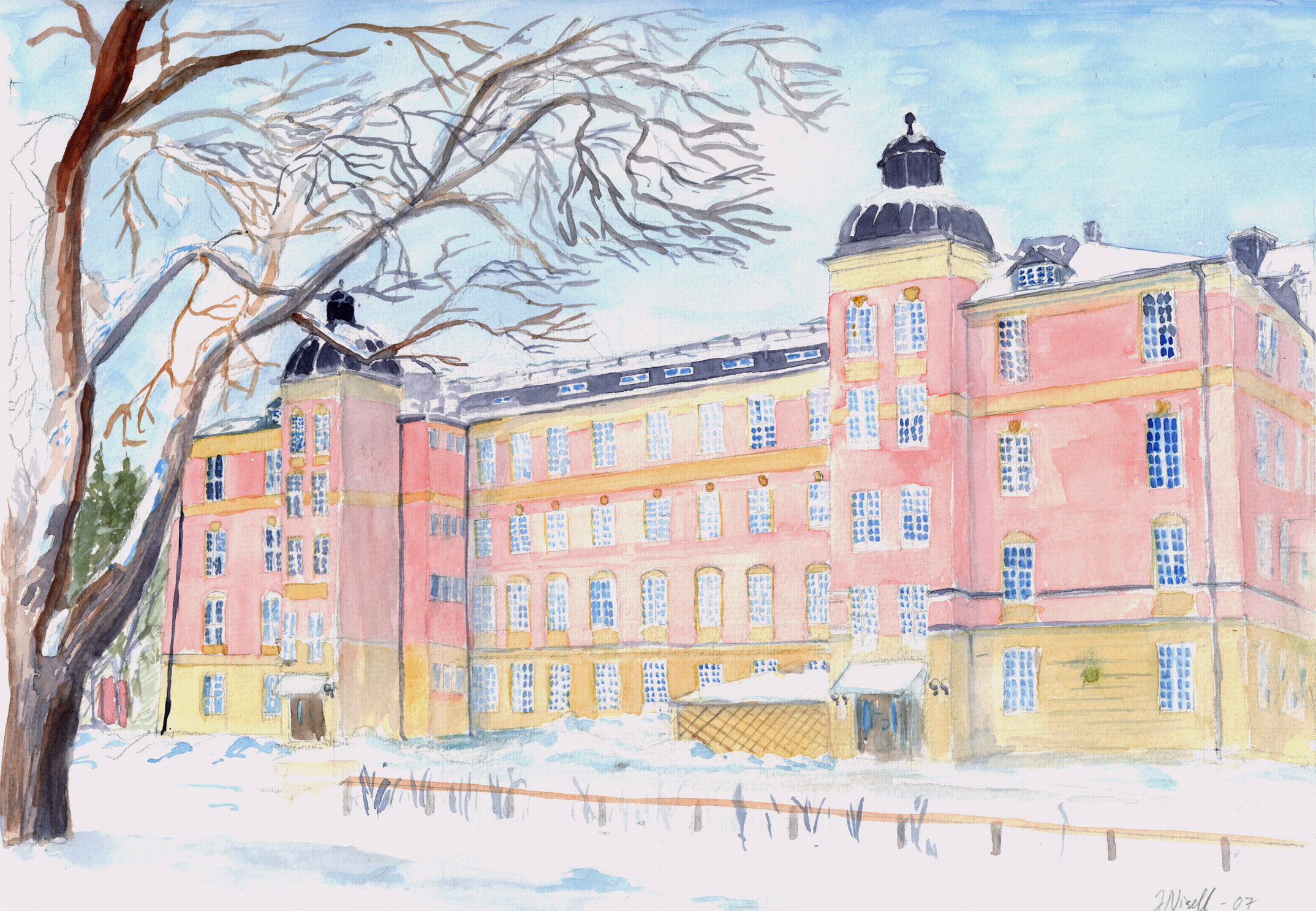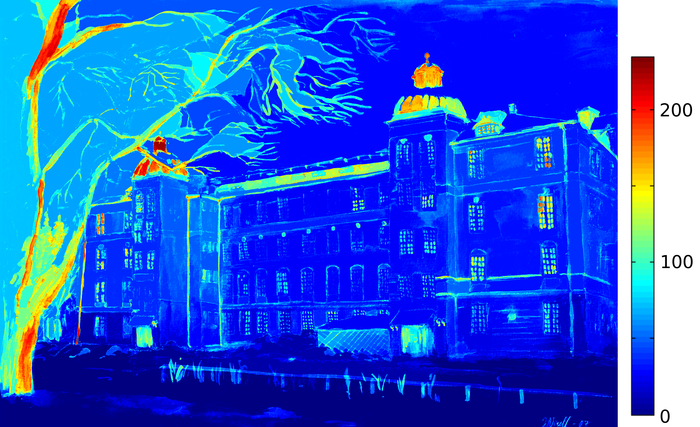 a |
 b |
Vladimir Curic, Cris Luengo, Gunilla Borgefors
Partner: Sébastien Lefèvre, VALORIA Research Laboratory in Computer Science, University of South Brittany, Vannes, France; Jesús Angulo, Centre for Mathematical Morphology, Ecole des Mines de Paris - MINES ParisTech, Fontainebleau, France; Anders Landström, Matthew Thurley, Luleå University of Technology, Luleå
Funding: Graduate School in Mathematics and Computing (FMB)
Period: 1101-
Abstract: The construction of adaptive structuring elements that adjust their shape and size to the local structures in the image has recently been a popular topic in mathematical morphology. Despite that several methods for the construction of spatially adaptive structuring elements have been proposed, it is still an open problem, both from a theoretical and implementation point of view.
We have proposed salience adaptive structuring elements that modify their shape and size according to the saliency of the edges in the image. We have examined topological properties of salience adaptive structuring elements and investigated their applicability to image filtering. This work has been published in IEEE Journal of Selected Topics in Signal Processing, Special Issue on Filtering and Segmentation With Mathematical Morphology. In addition, we have proposed structuring elements with the adaptive size of structuring elements based on similar type of the salience map as it was used for the construction of the salience adaptive structuring elements. Results of this study were presented at the International Conference on Computer Vision and Graphics (ICCVG'2012). Furthermore, we extended this work to salience-based structuring functions, which is currently under review.
We intend to further develop new methods for adaptive structuring elements as well as to extend the salience adaptive structuring elements toward multi-valued images and sparse image representations. Nonlocal morphological operators and adaptive morphological operators for both discrete and continuous framework are of interest in future studies.
Robin Strand, Filip Malmberg, Andreas Kårsnäs
Partner: Punam K. Saha, Dept. of Electrical and Computer Engineering and the Dept. of Radiology, University of Iowa, IA, USA; Krzysztof C. Ciesielski, Dept. of Mathematics, West Virginia University, Morgantown, WV, USA; Dept. of Radiology, MIPG, University of Pennsylvania, PA, USA
Funding: TN-faculty, UU
Period: 1103-
Abstract: In this project, we introduce a distance function on a fuzzy subset
that gives the minimum barrier that has to be passed to go from one
point to another, see Figure 18. Theoretical properties as well as efficient
computational solutions for minimum barrier distance have been
developed. An initial application of minimum barrier distance in
image segmentation is presented. The experiments show that the
minimum barrier distance is robust to noise and blur, and also seed
point position, since it captures the total change in membership
values across an interface instead of gradient as a measure of slope
that is sensitive to noise and blur.
A paper on the theoretical foundation of the minimum barrier distance was written and accepted for publication in Computer Vision and Image Understanding and a paper on the vectorial minimum barrier distance was presented at ICPR'12, see Project 28.
 a |
 b |
Robin Strand, Gunilla Borgefors
Partner: Benedek Nagy, Dept. of Computer Science, Faculty of Informatics, University of Debrecen, Hungary; Nicols Normand, IRCCyN, University of Nantes, France
Funding: TN-faculty, UU; S-faculty, SLU
Period: 9309-
Abstract: The distance between any two grid points in a grid is defined by a distance function. In this project, weighted distances have been considered for many years. A generalization of the weighted distances is obtained by using both weights and a neighborhood sequence to define the distance function. The neighborhood sequence allows the size of the neighborhood to vary along the paths. In 2012, Strand visited Normand for a month, and examined the link between integer sequences and distance functions. Also, a paper on distance transform computation by Strand and Normand was published in Theoretical Computer Science.
Kristína Lidayová, Hans Frimmel, Ewert Bengtsson
Partner: Örjan Smedby, Chunliang Wang, Center for Medical Image Science and Visualization (CMIV), Linköping University
Funding: VR grant to Örjan Smedby
Period: 1207-
Abstract: Precise segmentation of vascular structures is crucial for
studying the effect of stenoses on arterial blood flow. The goal of this project is to develop and evaluate vascular segmentation, which will be fast enough to permit interactive clinical use. The first part is the extraction of the centerline tree (skeleton) from the gray-scale CT image. Later this skeleton is used as a seed region. The method should offer sub-voxel accuracy.
The first half year we focused on familiarizing with the software and the previously developed methods for vascular segmentation.
Vladimir Curic, Hamid Sarve, Gunilla Borgefors
Partner: Joakim Lindblad, Nataša Sladoje, Faculty of Technical Sciences, University of Novi Sad, Serbia
Funding: Graduate School in Mathematics and Computing (FMB)
Period: 0908-
Abstract: Methods for measuring distances between sets, which is a measure of how similar the sets are, can be useful for solving various image analysis related problems,
such as registration, image retrieval and segmentation evaluation.
Depending on how the distance measure is defined, it exhibits different properties, such as metricity, monotonicity, continuity, sensitivity to noise, complexity and speed of computation.
It is therefore of interest to study and further develop different set distance measures, to be able to select appropriate distances for the different applications.
In this project, we evaluate existing and develop new set distances which are useful in image registration related problems.
We have proposed a new set distance between crisp sets of points and evaluated its usefulness for rigid body registration of binary images as well as its applicability for the real task of multi-modal 2D-3D registration of 2D histological sections of bone implant with corresponding 3D synchrotron radiation micro computed tomography (SRµCT) bone implant volumes. In addition, it has been shown that this set distance has good performances when applicable to the task of recognition of handwritten characters. This work has been accepted for publication to Pattern Analysis and Applications.
We extended our study to fuzzy objects and proposed four novel point-to-set distances defined for fuzzy or gray-level image data, two based on integration of alpha cuts and two based on the fuzzy distance transform. We further used these point-to-set distances to define distances between fuzzy sets. Theoretical study and performance evaluation of the proposed distances confirm their excellent behaviour in template matching and object classification. New distance measures enable to include and consider both spatial and intensity information, which makes them applicable to texture matching problems as well. The results of our study are submitted to a journal.
Erik Wernersson, Cris Luengo, Anders Brun, Gunilla Borgefors
Funding: S-faculty, SLU
Period: 1009 -
Abstract: Curvature is known as a useful local descriptor of 2D
surfaces, embedded in 3D space with applications ranging from
visualisation to segmentation. With this project, we aim to find
elegant ways to calculate curvature directly from volumetric data
which might be flawed with artifacts and noise. No intermediate
surface representations are used to ensure stability. The methods will
be useful in the analysis of µCT images of composite materials
where curvature can be used as a descriptor of several local
properties of wood fibres.